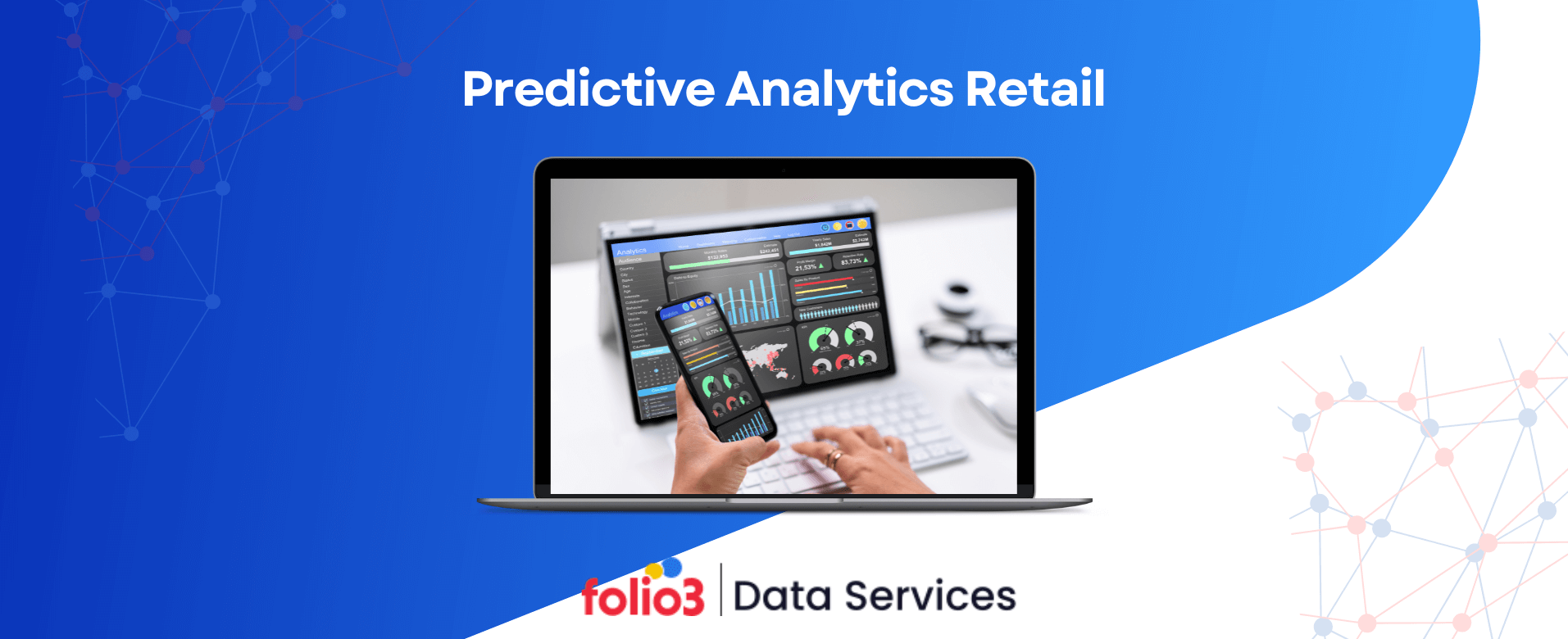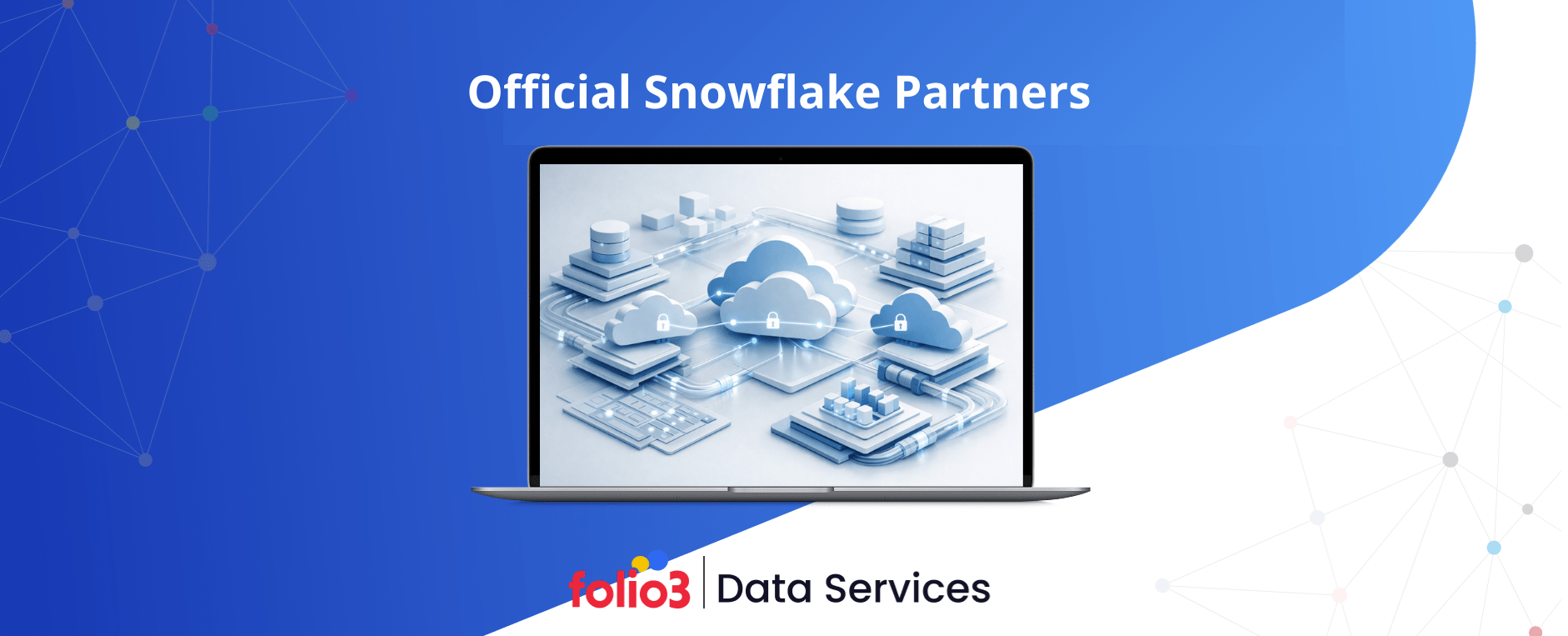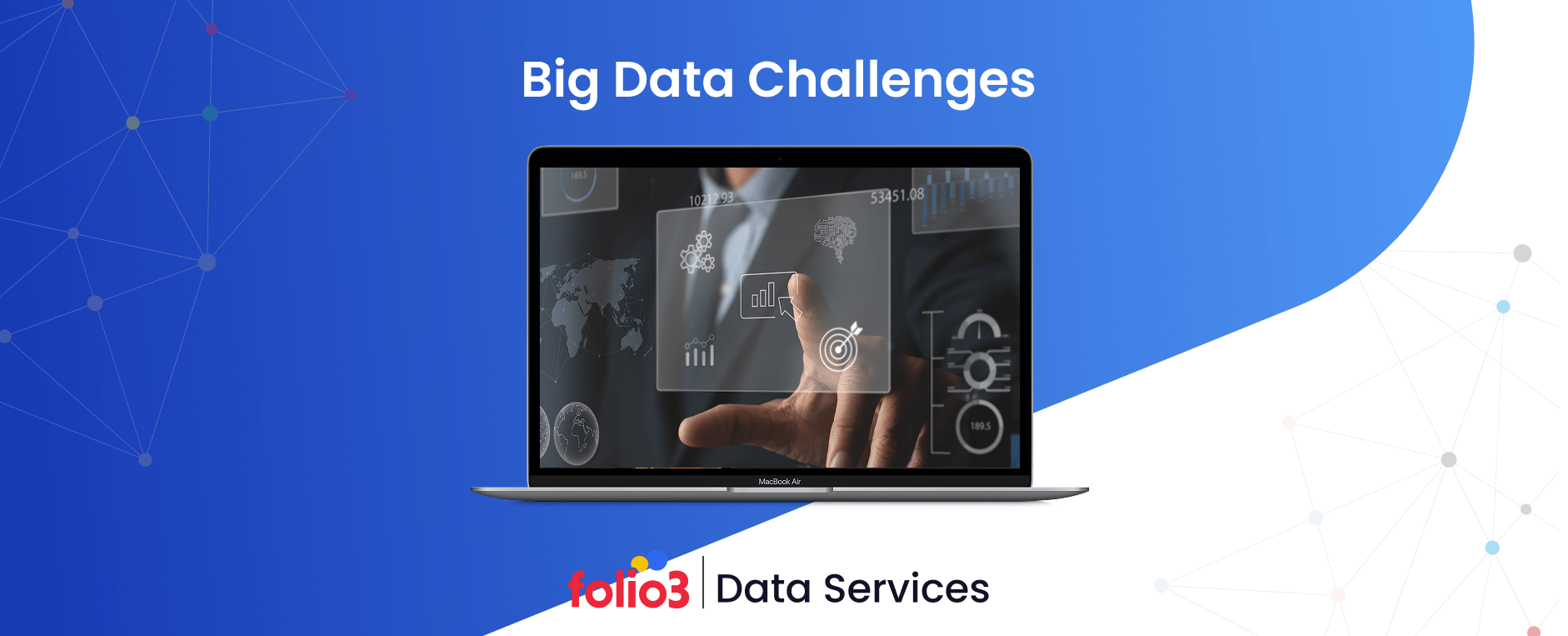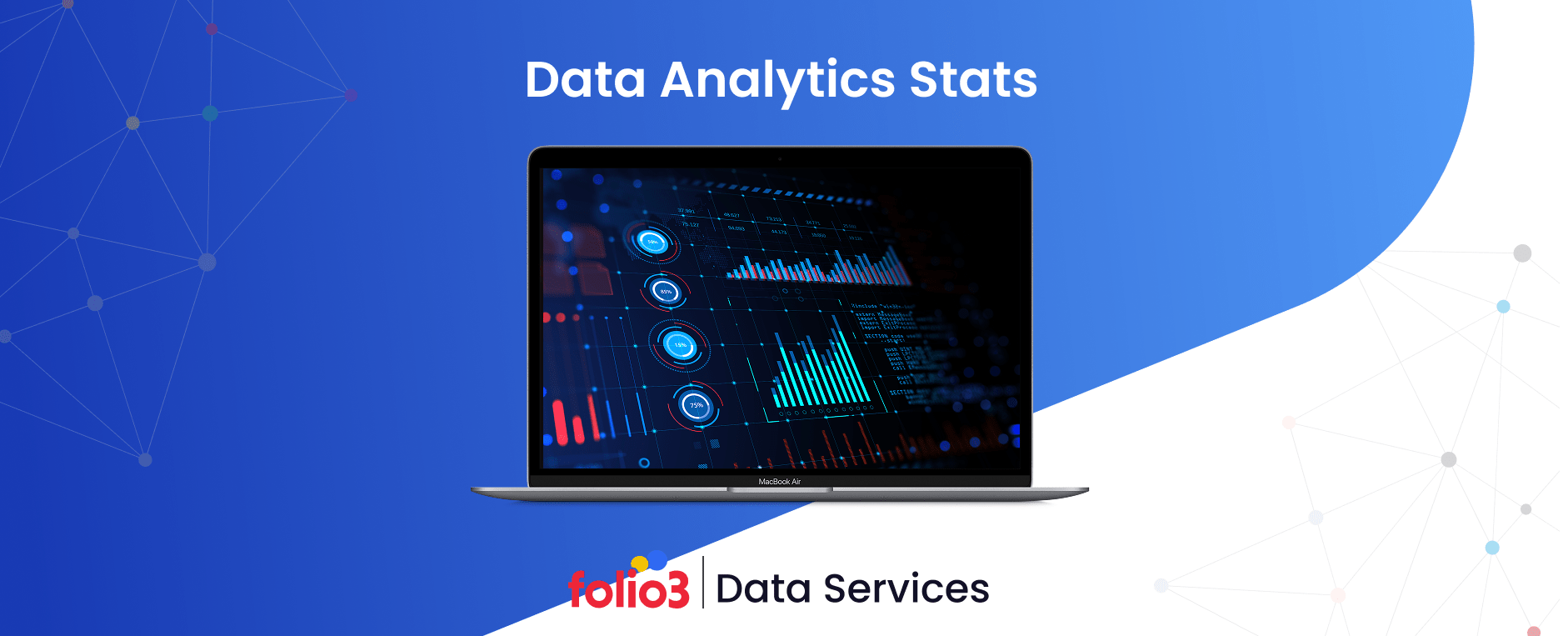Understanding and anticipating customer needs is paramount in today’s competitive retail industry. Retail predictive analytics is at the forefront of this transformation, providing businesses with the tools to harness the power of data and make informed decisions.
With the help of analyzing historical data and identifying trends, retailers can predict future behaviors, optimize operations, and deliver personalized experiences that drive growth. The impact of predictive analytics on the retail industry is profound. According to a study by
McKinsey, businesses that leverage predictive analytics see a 5-10% increase in revenue and a 20-30% reduction in operational costs.
Moreover, 62% of leading retailers reported that predictive analytics has significantly improved their understanding of customer behavior and preferences. This technology leads to better-targeted marketing campaigns and enhanced customer loyalty. It is not just a trend but a necessity for retailers aiming to stay competitive in a rapidly changing market.
As we delve deeper into how predictive analytics drives growth and transforms the retail industry, the potential for innovation and improvement becomes undeniable. Keep reading this blog to learn more about how retail predictive analytics drive growth in business and transform the retail industry.
What is Predictive Analytics in Retail?
Predictive analytics in retail refers to using statistical techniques, machine learning algorithms, and data analysis tools to forecast future outcomes based on historical data. It enables retailers to anticipate customer behaviors, market trends, and operational challenges, allowing them to make proactive and informed decisions.
Predictive analytics provides a comprehensive view of the retail landscape by integrating data from various sources, such as sales records, customer interactions, social media, and inventory systems. Leveraging data integration consulting services ensures seamless data integration, enabling businesses to identify patterns and trends that might not be immediately apparent through traditional analysis.
For example, a retailer might use predictive analytics to determine which products will likely sell during a specific season, allowing them to optimize stock levels and marketing efforts. Similarly, customer behavior analysis through predictive analytics can guide personalized recommendations, improving the shopping experience.
As the retail industry becomes increasingly data-driven, predictive analytics is proving to be a game-changer in enhancing efficiency, profitability, and customer satisfaction.
Benefits of Predictive Analytics for Retail
Predictive analytics offers many advantages for retailers, transforming how they operate and engage with customers. Retailers can use data-driven insights to enhance customer experiences, streamline operations, and achieve significant cost savings. Below, we explore some key benefits of predictive analytics in retail:
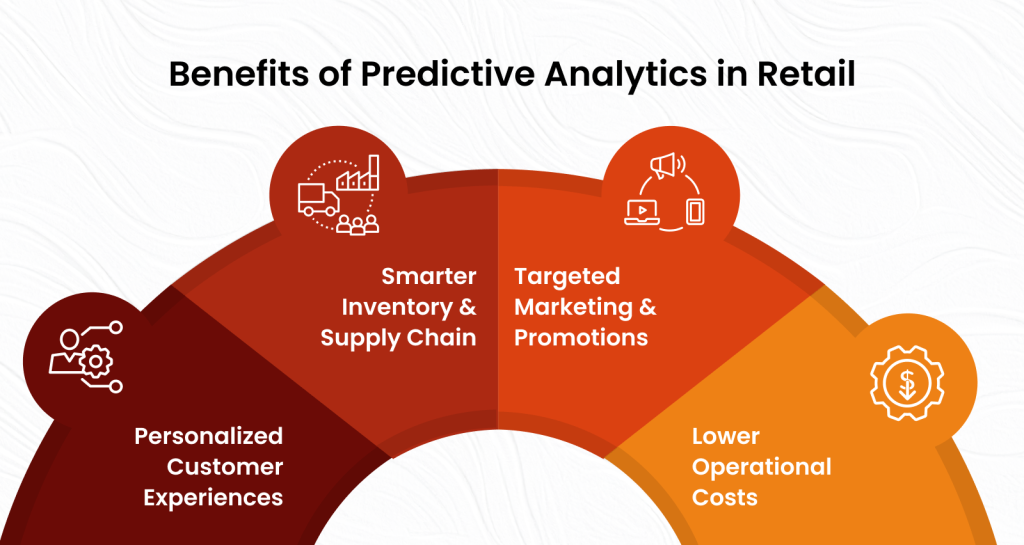
1. Enhancing Customer Experience with Personalized Recommendations
By analyzing customer purchase histories, browsing patterns, and preferences, predictive analytics empowers retailers to offer tailored recommendations. Leveraging customer analytics consulting can further enhance these efforts, enabling businesses to optimize their strategies and drive better customer engagement. For instance, Amazon’s recommendation engine, powered by predictive analytics, contributes 35% of its sales by suggesting relevant products to customers.
2. Optimizing Inventory and Supply Chain Management
Retail predictive analytics helps accurately forecast demand and ensure optimal stock levels. Many leading retailers now rely on retail supply chain predictive analytics to streamline logistics, improve demand forecasting, and enhance replenishment cycles. Walmart, for example, uses these capabilities to manage inventory across its vast network, reducing excess stock and avoiding stockouts, resulting in millions of dollars in cost savings annually.
3. Increasing Sales Through Targeted Marketing and Promotions
Targeted campaigns driven by predictive analytics yield higher conversion rates. Starbucks leverages predictive analytics to personalize its promotions, boosting customer engagement and loyalty by 10% year-over-year.
This is a prime example of how predictive analytics in retail industry strategies can drive more effective marketing and stronger customer relationships.
4. Reducing Operational Costs and Inefficiencies
By analyzing operational data, retailers can identify inefficiencies and optimize processes. For instance, predictive maintenance IoT solutions help minimize downtime and reduce costs by using sensor data to predict equipment failures before they occur.
This proactive approach not only ensures smoother operations but also prevents unexpected disruptions that can impact customer experience.
Key Use Cases of Predictive Analytics in Retail Industry
Predictive analytics has become a cornerstone for retailers aiming to stay competitive and deliver exceptional customer experiences. Below are the primary use cases that demonstrate how this technology transforms retail operations and strategies:
1. Customer Behavior Analysis: Understanding Shopping Patterns and Preferences
Predictive analytics lets retailers gain deep insights into customer behavior by analyzing purchase histories, browsing patterns, and demographic data. According to a study by Statista, personalization driven by predictive analytics in retail industry applications can increase a retailer’s revenue by up to 15%. This information helps in:
- Identifying trends: Retailers can understand which products are popular among specific customer segments.
- Personalized experiences: Tailored recommendations increase customer satisfaction and loyalty. For example, Sephora uses predictive analytics to suggest beauty products based on a customer’s past purchases and preferences.
2. Demand Forecasting: Predicting Product Demand to Avoid Stockouts and Overstock
By analyzing historical sales data, seasonality, and external factors like market trends or weather conditions, predictive analytics helps retailers accurately forecast demand. Leading brands like Zara rely on retail demand forecasting to align production and inventory with anticipated consumer needs, enabling them to respond quickly to changing fashion trends. This prevents:
- Stockouts: Ensuring shelves are stocked with high-demand items during peak seasons.
- Overstock: Reducing excess inventory that ties up resources.
3. Pricing Optimization: Dynamic Pricing Strategies Based on Market Trends
Retail pricing predictive analytics helps determine optimal pricing strategies by considering factors like competitor pricing, customer willingness to pay, and market demand. A prime example is Amazon’s dynamic pricing strategies, powered by predictive analytics. It adjusts product prices multiple times daily to reflect demand and competition. Benefits include:
- Dynamic pricing: Adjusting prices in real-time to maximize revenue and competitiveness.
- Profitability: Identifying price points that attract customers without compromising profit margins.
4. Churn Prediction: Identifying and Retaining At-Risk Customers
Retaining existing customers is more cost-effective than acquiring new ones. By applying advanced predictive analytics techniques, retailers can analyze customer behavior, purchase frequency, and engagement levels to identify those at risk of leaving. According to Deloitte, retailers using churn prediction can reduce churn rates by up to 10%.
- Loyalty programs: Offering discounts or rewards to re-engage customers.
- Personalized outreach: Sending targeted emails or promotions to address specific customer needs.
5. Fraud Detection: Identifying Unusual Patterns to Prevent Fraudulent Activities
Predictive analytics is instrumental in identifying anomalies in transaction data that may indicate fraud. For example, Walmart uses predictive analytics to monitor transaction data in real-time, identifying suspicious activities and preventing fraud before it occurs. With the help of machine learning algorithms, retailers can:
- Detect fraud early: Spot unusual purchasing patterns or return activities.
- Protect revenue: Reduce losses caused by fraudulent transactions.
How to Improve Retail Businesses With Predictive Analytics?
Predictive analytics reshapes the retail industry by enabling businesses to anticipate customer behaviors, optimize operations, and make data-driven decisions.
Below are the key strategies where predictive analytics delivers tangible value:
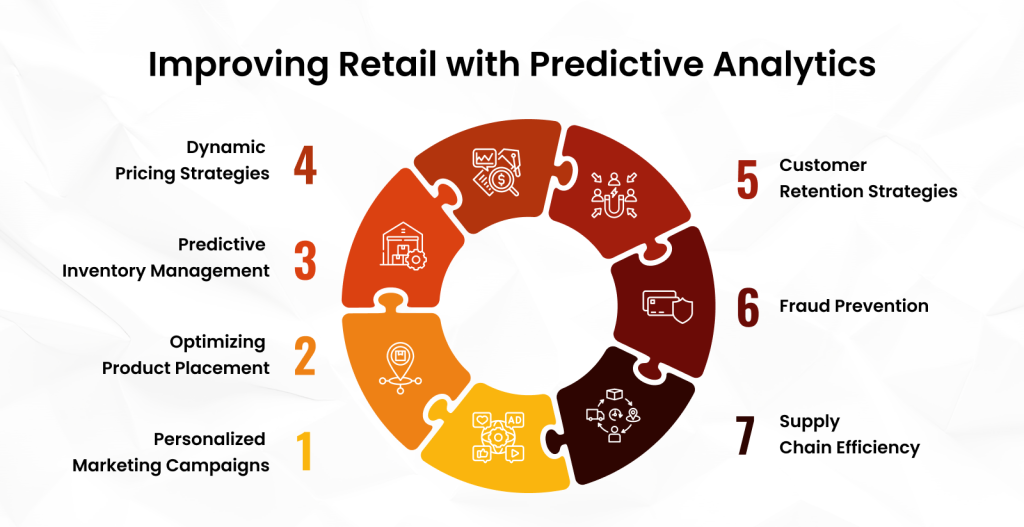
1. Personalized Marketing Campaigns
Predictive analytics allows retailers to analyze customer purchase histories, browsing behaviors, and demographics to create highly targeted marketing campaigns. By combining predictive models with customer analytics in retail industry, businesses can better understand individual preferences and trends. This helps them:
- Enhance engagement: Deliver personalized emails or product recommendations.
- Increase ROI: Focus on customers most likely to convert.
2. Optimizing Product Placement
Retailers can use predictive analytics to determine the best locations for product displays based on sales data and customer traffic patterns. Benefits include:
- Maximizing visibility: Positioning high-demand products where customers are most likely to see them.
- Driving impulse purchases: Strategically placing complementary items together.
3. Predictive Inventory Management
Inventory management is crucial for preventing stockouts and overstocking, ensuring that businesses maintain the right balance to meet customer demand while avoiding unnecessary costs. Predictive analytics, powered by data analytics solutions, leverages historical sales data and demand forecasting to optimize inventory processes.
- Balance stock levels: Ensure sufficient inventory during peak seasons.
- Reduce waste: Avoid over-ordering perishable goods.
4. Dynamic Pricing Strategies
Dynamic pricing involves real-time adjusting product prices based on demand, competition, and market trends. Predictive retail analytics enables:
- Competitive pricing: Setting prices that attract customers while maximizing margins.
- Revenue optimization: Adjusting prices during high-demand periods.
5. Customer Retention Strategies
Retaining customers is more cost-effective than acquiring new ones. Predictive analytics identifies at-risk customers by analyzing:
- Purchase patterns: Detecting changes in frequency or spending.
- Engagement levels: Monitoring inactivity or reduced interactions.
6. Fraud Prevention
Retailers face significant losses from fraudulent activities, including unauthorized transactions or returns. Predictive retail analytics helps:
- Spot anomalies: Identify unusual patterns in purchase or return data.
- Prevent fraud: Flag suspicious activities in real time.
7. Supply Chain Efficiency
Predictive analytics enhances supply chain operations by forecasting demand and identifying bottlenecks. In particular, predictive analytics in retail stores helps optimize inventory management, ensuring shelves are stocked with the right products at the right time.
- Optimized logistics: Plan efficient routes and delivery schedules.
- Reduced costs: Minimize delays and unnecessary expenses.
Retail Predictive Analytics Case Studies & Examples
Retailers increasingly use predictive analytics to refine operations, enhance customer experiences, and drive growth. Here are some real-world examples highlighting how leading retailers are leveraging this technology:
1. Walmart’s AI-Powered Inventory Management
Walmart has integrated predictive analytics into its inventory management system, especially during peak seasons like the holidays. Their AI and machine learning (ML) models use historical data, consumer behavior, weather patterns, and macroeconomic trends to predict demand and optimize inventory flow.
For example, by analyzing past sales data and combining it with ‘future data’ such as local weather patterns, Walmart’s system anticipates demand shifts and allocates stock accordingly. This allows Walmart to maintain an optimal inventory distribution across its 4,700 stores and fulfillment centers, ensuring that customers can find exactly what they need when they need it.
Moreover, Walmart’s predictive analytics engine also accounts for anomalies like weather disruptions or unexpected purchasing spikes and adjusts forecasts to avoid future errors. For instance, if an unprecedented weather event (e.g., a snowstorm in Florida) affects sales patterns, the system “forgets” this anomaly to avoid skewing future predictions. This ensures that Walmart’s inventory management process stays on track, even in unexpected circumstances.
2. Target’s Predictive Analytics for Personalized Customer Experiences
Target uses predictive analytics to create personalized shopping experiences. The company leverages data from customer purchase history, online browsing behavior, and even location data to predict what products a customer may be interested in, both online and in-store. Their predictive models recommend products to customers, improving the chances of a sale while enhancing the overall shopping experience.
Additionally, Target uses analytics to predict when a customer may be running out of household essentials, sending them timely reminders or coupons to encourage repeat purchases. This personalization boosts customer satisfaction and drives increased revenue by anticipating customers’ needs.
Technologies and Tools for Retail Predictive Analytics
Implementing predictive analytics in retail relies on advanced technologies and tools designed to process large datasets, apply sophisticated algorithms, and deliver actionable insights. Below are the key categories of technologies and tools that enable retailers to unlock the potential of predictive analytics:
1. Machine Learning and AI Platforms
Machine learning (ML) and artificial intelligence (AI) platforms are the backbone of predictive analytics. These platforms allow retailers to develop and deploy predictive models that can analyze vast amounts of data and learn from it to make accurate forecasts.
In fact, predictive analytics in retail stores often relies on these platforms to personalize recommendations, optimize inventory, and prevent fraud.
- TensorFlow: Google’s open-source framework for developing predictive models in retail is widely used. It supports deep learning techniques, making it ideal for analyzing complex patterns such as customer preferences or inventory trends.
- PyTorch: Another open-source ML framework known for its flexibility and ease of use, PyTorch is often used to build predictive models for personalized recommendations or fraud detection.
Benefits
- Automates repetitive tasks like customer segmentation and demand forecasting.
- Enhances decision-making with AI-powered insights.
2. Big Data Tools
Big data tools enable retailers to process and analyze enormous datasets efficiently, uncovering critical patterns and trends for predictive analytics. These tools handle structured, semi-structured, and unstructured data, ensuring comprehensive insights.
In fact, platforms like Hadoop and Apache Spark form the foundation of big data predictive analytics, helping retailers transform raw data into actionable insights that power demand forecasting, dynamic pricing, and fraud detection.
- Hadoop: A distributed storage and processing framework that can manage massive datasets, Hadoop is ideal for processing customer data, sales records, and social media interactions.
- Apache Spark: Known for its speed and scalability, Apache Spark allows retailers to process data in real-time, which is crucial for dynamic pricing and fraud detection.
Benefits
- Handles large-scale data processing with ease.
- Supports real-time analytics for faster decision-making.
3. Cloud-Based Analytics Services
Cloud-based analytics platforms provide scalable, cost-effective solutions for deploying predictive analytics. These platforms integrate storage, computation, and advanced analytics capabilities, enabling retailers to access insights from anywhere.
Many providers now offer predictive analytics services that combine cloud infrastructure with machine learning, allowing retailers to implement models quickly without heavy upfront investment.
- AWS (Amazon Web Services) Offers services like Amazon SageMaker for building ML models and Redshift for data warehousing, helping retailers seamlessly implement predictive analytics.
- Google Cloud: Provides tools like BigQuery for real-time data analysis and AutoML for creating custom predictive models.
- Microsoft Azure: Features Azure Machine Learning and Synapse Analytics to help retailers streamline data processing and predictive modeling.
Benefits
- Eliminates the need for on-premise infrastructure, reducing costs.
- Enhances collaboration with centralized, cloud-based access to insights.
FAQs
How does predictive analytics improve customer experience in retail?
By analyzing customer purchase histories, browsing behavior, and preferences, predictive analytics enables retailers to provide personalized product recommendations, targeted promotions, and loyalty rewards—leading to higher engagement and satisfaction.
What are the benefits of predictive analytics for retail businesses?
Key benefits include improved demand forecasting, reduced operational costs, better inventory management, personalized marketing campaigns, dynamic pricing, fraud detection, and increased sales through data-driven strategies.
How is predictive analytics used in retail inventory management?
Retailers use predictive analytics to forecast demand, optimize stock levels, and prevent overstock or stockouts. This ensures the right products are available at the right time, reducing costs while maximizing customer satisfaction.
Can predictive analytics help with dynamic pricing in retail?
Yes, predictive analytics supports dynamic pricing by analyzing competitor prices, customer demand, and market conditions. This allows retailers to adjust prices in real time, improving competitiveness and profitability.
What role does predictive analytics play in fraud detection?
Predictive analytics uses machine learning models to detect anomalies in transaction data, helping retailers identify fraudulent activities such as unusual purchases, returns, or payment behavior. This prevents losses and enhances security.
What are the main use cases of predictive analytics in retail industry?
The retail industry leverages numerous predictive analytics use cases in retail to gain a competitive edge. Common applications include demand forecasting to anticipate customer needs, pricing optimization to maximize revenue, and customer behavior analysis to personalize marketing campaigns. Other key use cases involve churn prediction, fraud detection, inventory management, and supply chain optimization, all of which help retailers make data-driven decisions and improve operational efficiency.
What are some real-world examples of predictive analytics in retail?
Walmart uses AI-powered predictive models for inventory management, Target personalizes customer shopping experiences, Amazon applies dynamic pricing, and Starbucks uses predictive analytics for tailored promotions—driving higher sales and loyalty.
How is AI predictive analytics transforming the retail industry?
AI predictive analytics helps retailers forecast demand, optimize inventory, personalize marketing, and improve customer experiences. By analyzing large volumes of data—such as purchase history, browsing behavior, and market trends—AI enables retailers to anticipate customer needs, reduce stockouts or overstocking, and make data-driven decisions that boost sales and operational efficiency.
Conclusion
Predictive analytics revolutionizes the retail industry by enabling businesses to anticipate customer behavior, optimize operations, and enhance decision-making. With its ability to personalize marketing, maximize inventory, and improve customer retention, this technology drives growth and operational efficiency.
Retailers who use predictive analytics can stay ahead of market trends and create exceptional customer experiences. To maximize the benefits of predictive analytics, businesses can rely on Folio3’s data solutions, which offer robust tools and expertise to help retailers implement and scale these strategies effectively.
So, empower your retail business with Folio3’s innovative data solutions for sustained growth.
